Critical Reflection on Managing Diversity, Racism and Gender
VerifiedAdded on 2023/06/04
|14
|3706
|73
AI Summary
This critical reflection discusses managing diversity, racism and gender in the workplace. It explores the evolution from EEO to managing diversity, similarities and differences, and the issue of racism and gender discrimination. It also examines the role of diversity management in achieving human rights and equity.
Contribute Materials
Your contribution can guide someone’s learning journey. Share your
documents today.
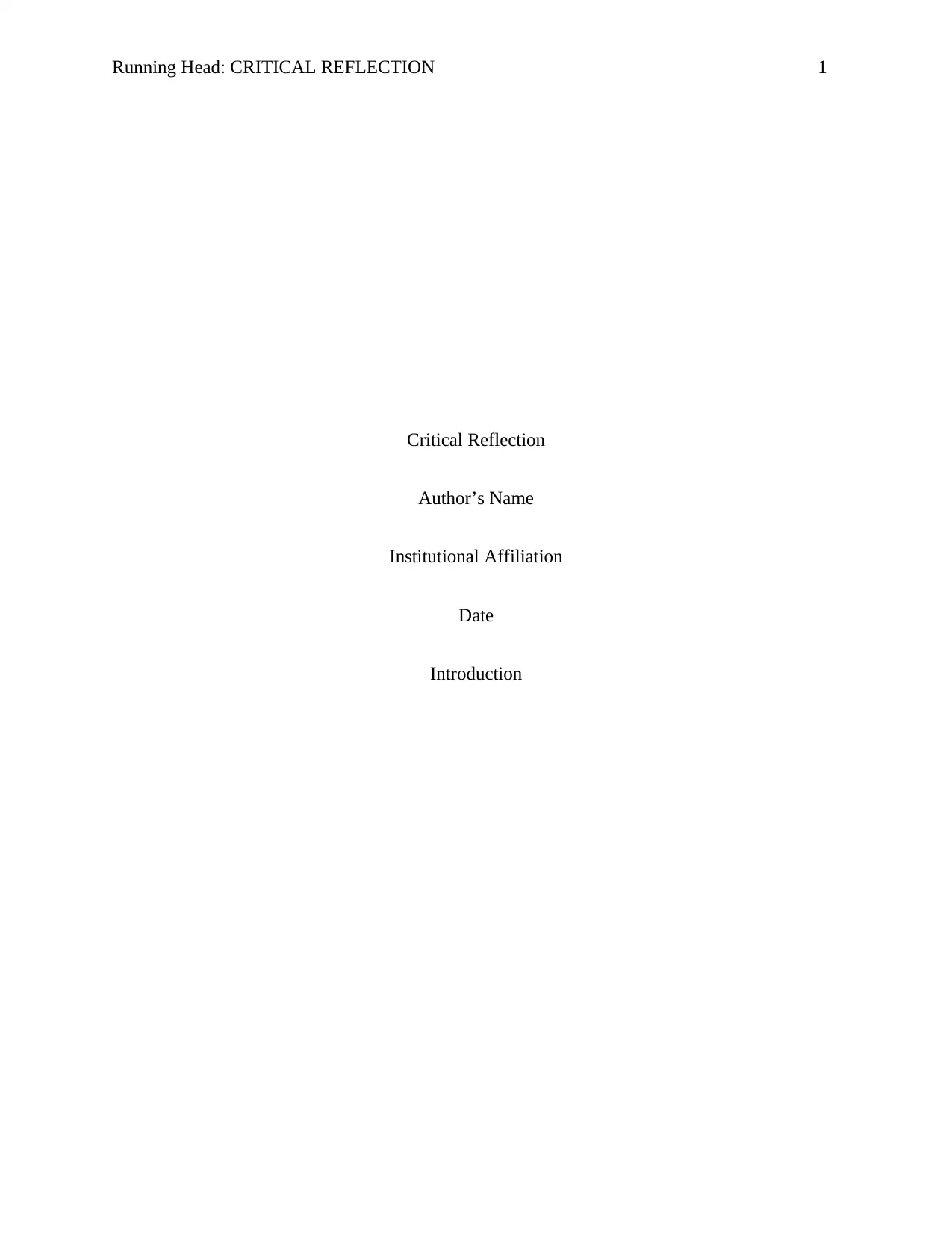
Running Head: CRITICAL REFLECTION 1
Critical Reflection
Author’s Name
Institutional Affiliation
Date
Introduction
Critical Reflection
Author’s Name
Institutional Affiliation
Date
Introduction
Secure Best Marks with AI Grader
Need help grading? Try our AI Grader for instant feedback on your assignments.

CRITICAL REFLECTION 2
Critical Reflection
Introduction
When a person takes a look at the society, they are able to see people of different sex,
race, religion and national originality. Migration and globalization have fueled diversity in many
countries that at some point viewed themselves as homogenous. With these dynamics in the
population, the society is heterogeneous and needs of all people must be met in the workplace
regardless of their demographic differences. Also, profit organizations target diverse customers,
and research shows that to attract diverse customers the workforce must be diverse (Hughes,
2015). It is due to that organizations are finding it necessary to manage diversity, as a way to
increase their competitiveness and promote cohesiveness that facilitates a favorable business
environment. Fundamentally, as a student of international tourism management, business
management, I am really challenged on how to build a diverse workforce that is tolerant and
respectful to customers in future. However, now that I have some knowledge of HRM, culture
and society, I believe that I am able to hire and manage diverse employees for organizational
success.
Evolution from EEO to Managing Diversity, similarities and differences
. With diverse people present in the work environment, equal employment opportunity,
became unavoidable concept. Roberson, Ryan, & Ragins, (2017) give a critical insight into the
rise of diversity managing, by alluding it to the formational of EEO laws. These EEO laws, at
first protected some classes of race, ethnicity and sex. Little focus was given to other issues like
age, religion, disability among other key differences like national originality. What the point
Critical Reflection
Introduction
When a person takes a look at the society, they are able to see people of different sex,
race, religion and national originality. Migration and globalization have fueled diversity in many
countries that at some point viewed themselves as homogenous. With these dynamics in the
population, the society is heterogeneous and needs of all people must be met in the workplace
regardless of their demographic differences. Also, profit organizations target diverse customers,
and research shows that to attract diverse customers the workforce must be diverse (Hughes,
2015). It is due to that organizations are finding it necessary to manage diversity, as a way to
increase their competitiveness and promote cohesiveness that facilitates a favorable business
environment. Fundamentally, as a student of international tourism management, business
management, I am really challenged on how to build a diverse workforce that is tolerant and
respectful to customers in future. However, now that I have some knowledge of HRM, culture
and society, I believe that I am able to hire and manage diverse employees for organizational
success.
Evolution from EEO to Managing Diversity, similarities and differences
. With diverse people present in the work environment, equal employment opportunity,
became unavoidable concept. Roberson, Ryan, & Ragins, (2017) give a critical insight into the
rise of diversity managing, by alluding it to the formational of EEO laws. These EEO laws, at
first protected some classes of race, ethnicity and sex. Little focus was given to other issues like
age, religion, disability among other key differences like national originality. What the point
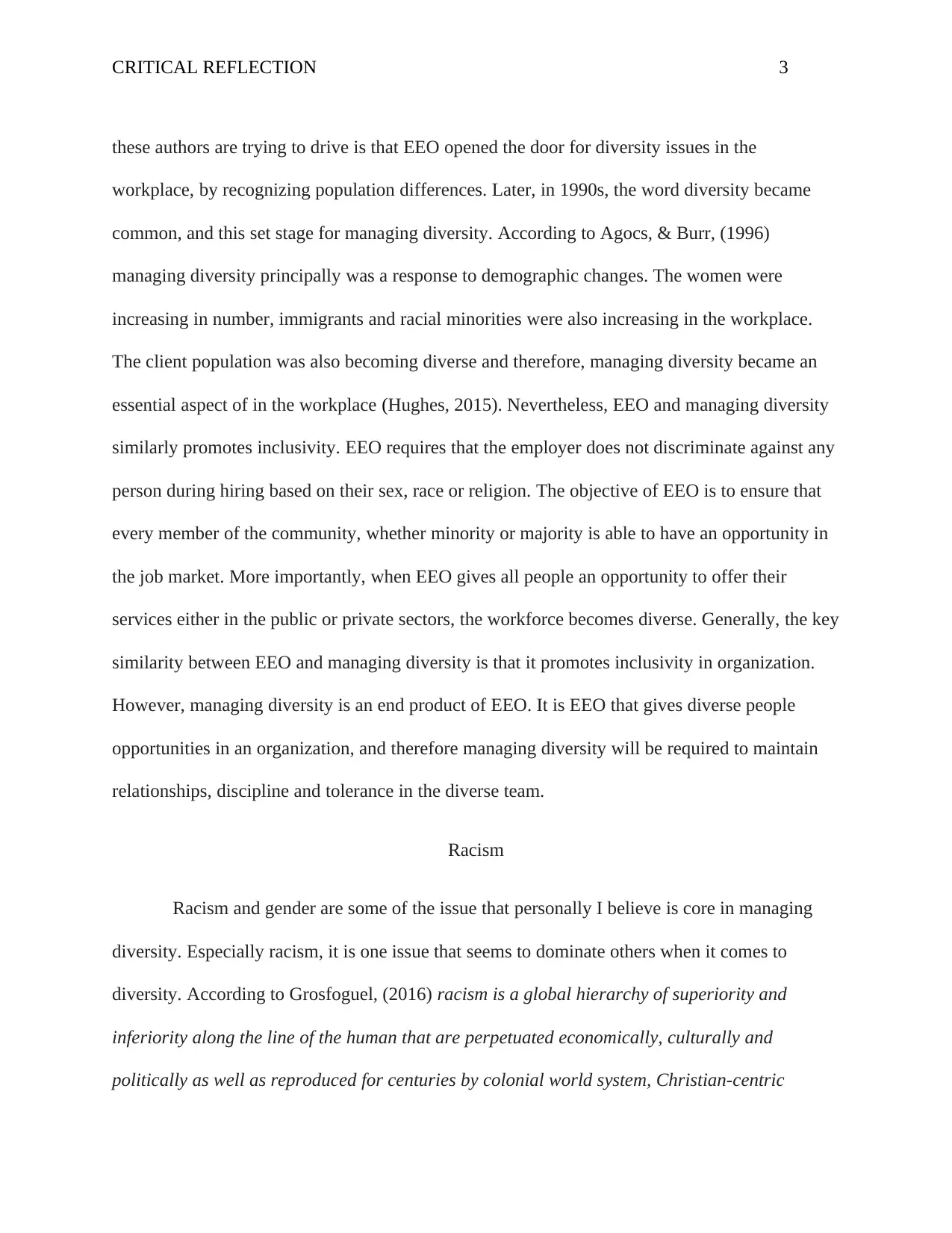
CRITICAL REFLECTION 3
these authors are trying to drive is that EEO opened the door for diversity issues in the
workplace, by recognizing population differences. Later, in 1990s, the word diversity became
common, and this set stage for managing diversity. According to Agocs, & Burr, (1996)
managing diversity principally was a response to demographic changes. The women were
increasing in number, immigrants and racial minorities were also increasing in the workplace.
The client population was also becoming diverse and therefore, managing diversity became an
essential aspect of in the workplace (Hughes, 2015). Nevertheless, EEO and managing diversity
similarly promotes inclusivity. EEO requires that the employer does not discriminate against any
person during hiring based on their sex, race or religion. The objective of EEO is to ensure that
every member of the community, whether minority or majority is able to have an opportunity in
the job market. More importantly, when EEO gives all people an opportunity to offer their
services either in the public or private sectors, the workforce becomes diverse. Generally, the key
similarity between EEO and managing diversity is that it promotes inclusivity in organization.
However, managing diversity is an end product of EEO. It is EEO that gives diverse people
opportunities in an organization, and therefore managing diversity will be required to maintain
relationships, discipline and tolerance in the diverse team.
Racism
Racism and gender are some of the issue that personally I believe is core in managing
diversity. Especially racism, it is one issue that seems to dominate others when it comes to
diversity. According to Grosfoguel, (2016) racism is a global hierarchy of superiority and
inferiority along the line of the human that are perpetuated economically, culturally and
politically as well as reproduced for centuries by colonial world system, Christian-centric
these authors are trying to drive is that EEO opened the door for diversity issues in the
workplace, by recognizing population differences. Later, in 1990s, the word diversity became
common, and this set stage for managing diversity. According to Agocs, & Burr, (1996)
managing diversity principally was a response to demographic changes. The women were
increasing in number, immigrants and racial minorities were also increasing in the workplace.
The client population was also becoming diverse and therefore, managing diversity became an
essential aspect of in the workplace (Hughes, 2015). Nevertheless, EEO and managing diversity
similarly promotes inclusivity. EEO requires that the employer does not discriminate against any
person during hiring based on their sex, race or religion. The objective of EEO is to ensure that
every member of the community, whether minority or majority is able to have an opportunity in
the job market. More importantly, when EEO gives all people an opportunity to offer their
services either in the public or private sectors, the workforce becomes diverse. Generally, the key
similarity between EEO and managing diversity is that it promotes inclusivity in organization.
However, managing diversity is an end product of EEO. It is EEO that gives diverse people
opportunities in an organization, and therefore managing diversity will be required to maintain
relationships, discipline and tolerance in the diverse team.
Racism
Racism and gender are some of the issue that personally I believe is core in managing
diversity. Especially racism, it is one issue that seems to dominate others when it comes to
diversity. According to Grosfoguel, (2016) racism is a global hierarchy of superiority and
inferiority along the line of the human that are perpetuated economically, culturally and
politically as well as reproduced for centuries by colonial world system, Christian-centric
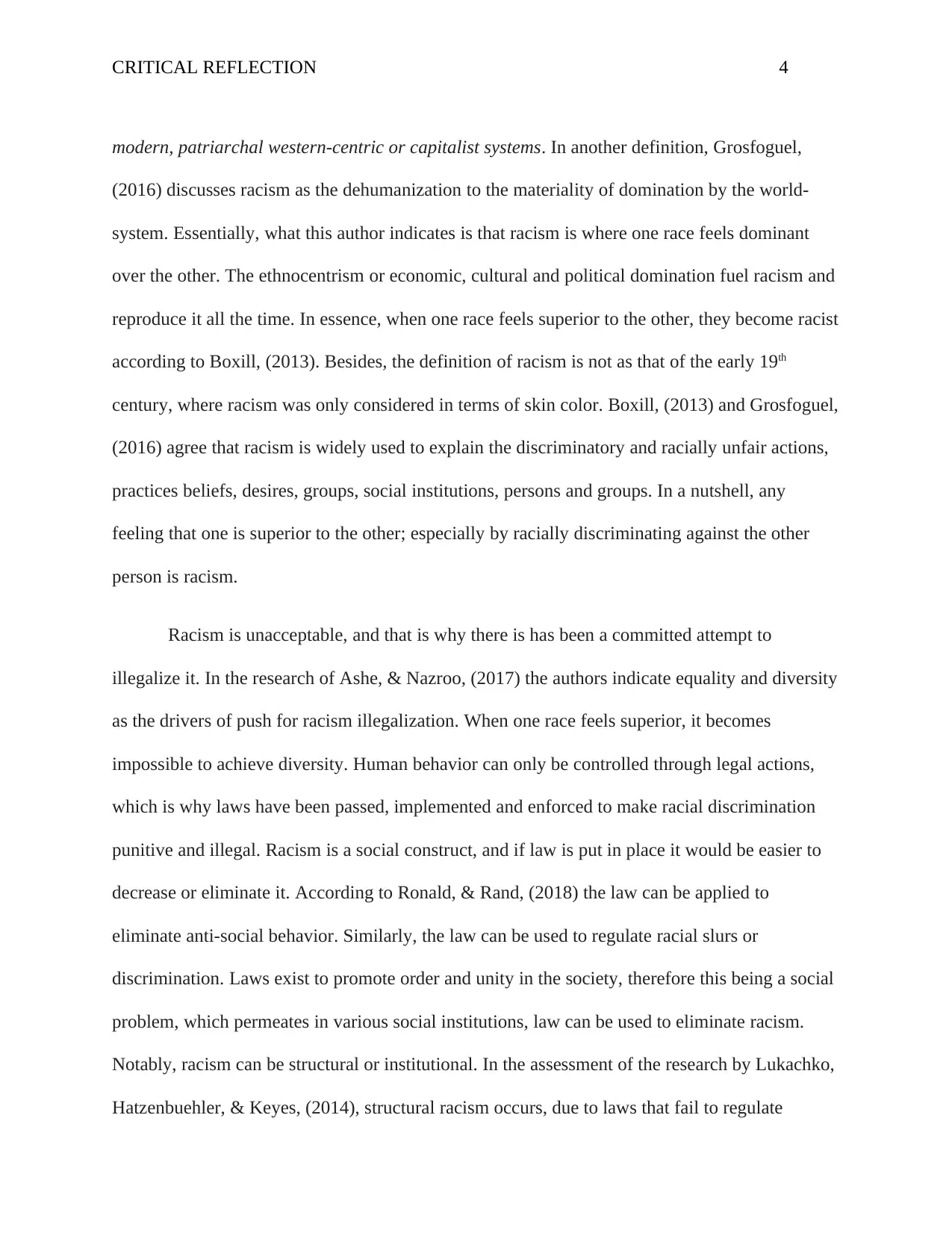
CRITICAL REFLECTION 4
modern, patriarchal western-centric or capitalist systems. In another definition, Grosfoguel,
(2016) discusses racism as the dehumanization to the materiality of domination by the world-
system. Essentially, what this author indicates is that racism is where one race feels dominant
over the other. The ethnocentrism or economic, cultural and political domination fuel racism and
reproduce it all the time. In essence, when one race feels superior to the other, they become racist
according to Boxill, (2013). Besides, the definition of racism is not as that of the early 19th
century, where racism was only considered in terms of skin color. Boxill, (2013) and Grosfoguel,
(2016) agree that racism is widely used to explain the discriminatory and racially unfair actions,
practices beliefs, desires, groups, social institutions, persons and groups. In a nutshell, any
feeling that one is superior to the other; especially by racially discriminating against the other
person is racism.
Racism is unacceptable, and that is why there is has been a committed attempt to
illegalize it. In the research of Ashe, & Nazroo, (2017) the authors indicate equality and diversity
as the drivers of push for racism illegalization. When one race feels superior, it becomes
impossible to achieve diversity. Human behavior can only be controlled through legal actions,
which is why laws have been passed, implemented and enforced to make racial discrimination
punitive and illegal. Racism is a social construct, and if law is put in place it would be easier to
decrease or eliminate it. According to Ronald, & Rand, (2018) the law can be applied to
eliminate anti-social behavior. Similarly, the law can be used to regulate racial slurs or
discrimination. Laws exist to promote order and unity in the society, therefore this being a social
problem, which permeates in various social institutions, law can be used to eliminate racism.
Notably, racism can be structural or institutional. In the assessment of the research by Lukachko,
Hatzenbuehler, & Keyes, (2014), structural racism occurs, due to laws that fail to regulate
modern, patriarchal western-centric or capitalist systems. In another definition, Grosfoguel,
(2016) discusses racism as the dehumanization to the materiality of domination by the world-
system. Essentially, what this author indicates is that racism is where one race feels dominant
over the other. The ethnocentrism or economic, cultural and political domination fuel racism and
reproduce it all the time. In essence, when one race feels superior to the other, they become racist
according to Boxill, (2013). Besides, the definition of racism is not as that of the early 19th
century, where racism was only considered in terms of skin color. Boxill, (2013) and Grosfoguel,
(2016) agree that racism is widely used to explain the discriminatory and racially unfair actions,
practices beliefs, desires, groups, social institutions, persons and groups. In a nutshell, any
feeling that one is superior to the other; especially by racially discriminating against the other
person is racism.
Racism is unacceptable, and that is why there is has been a committed attempt to
illegalize it. In the research of Ashe, & Nazroo, (2017) the authors indicate equality and diversity
as the drivers of push for racism illegalization. When one race feels superior, it becomes
impossible to achieve diversity. Human behavior can only be controlled through legal actions,
which is why laws have been passed, implemented and enforced to make racial discrimination
punitive and illegal. Racism is a social construct, and if law is put in place it would be easier to
decrease or eliminate it. According to Ronald, & Rand, (2018) the law can be applied to
eliminate anti-social behavior. Similarly, the law can be used to regulate racial slurs or
discrimination. Laws exist to promote order and unity in the society, therefore this being a social
problem, which permeates in various social institutions, law can be used to eliminate racism.
Notably, racism can be structural or institutional. In the assessment of the research by Lukachko,
Hatzenbuehler, & Keyes, (2014), structural racism occurs, due to laws that fail to regulate
Secure Best Marks with AI Grader
Need help grading? Try our AI Grader for instant feedback on your assignments.
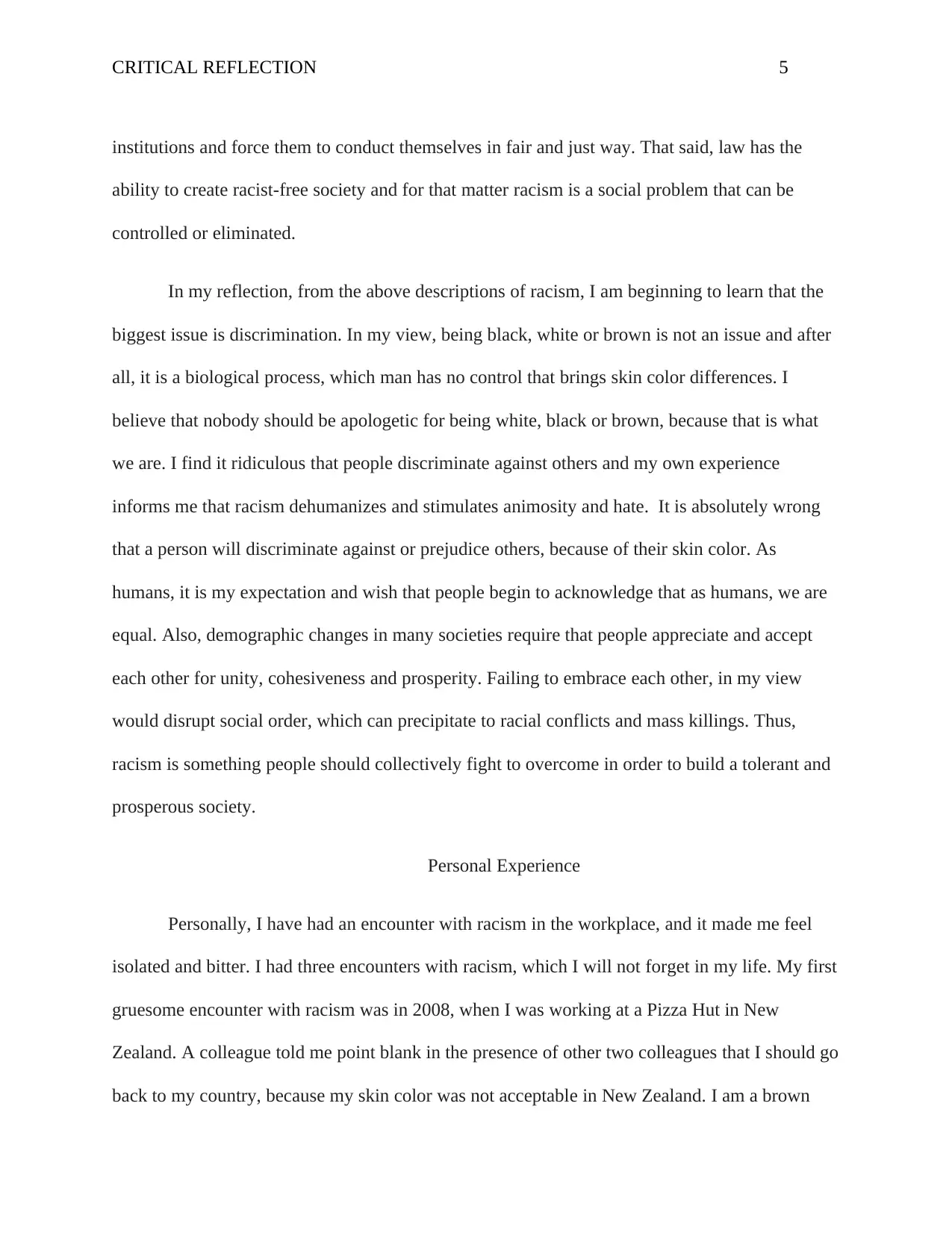
CRITICAL REFLECTION 5
institutions and force them to conduct themselves in fair and just way. That said, law has the
ability to create racist-free society and for that matter racism is a social problem that can be
controlled or eliminated.
In my reflection, from the above descriptions of racism, I am beginning to learn that the
biggest issue is discrimination. In my view, being black, white or brown is not an issue and after
all, it is a biological process, which man has no control that brings skin color differences. I
believe that nobody should be apologetic for being white, black or brown, because that is what
we are. I find it ridiculous that people discriminate against others and my own experience
informs me that racism dehumanizes and stimulates animosity and hate. It is absolutely wrong
that a person will discriminate against or prejudice others, because of their skin color. As
humans, it is my expectation and wish that people begin to acknowledge that as humans, we are
equal. Also, demographic changes in many societies require that people appreciate and accept
each other for unity, cohesiveness and prosperity. Failing to embrace each other, in my view
would disrupt social order, which can precipitate to racial conflicts and mass killings. Thus,
racism is something people should collectively fight to overcome in order to build a tolerant and
prosperous society.
Personal Experience
Personally, I have had an encounter with racism in the workplace, and it made me feel
isolated and bitter. I had three encounters with racism, which I will not forget in my life. My first
gruesome encounter with racism was in 2008, when I was working at a Pizza Hut in New
Zealand. A colleague told me point blank in the presence of other two colleagues that I should go
back to my country, because my skin color was not acceptable in New Zealand. I am a brown
institutions and force them to conduct themselves in fair and just way. That said, law has the
ability to create racist-free society and for that matter racism is a social problem that can be
controlled or eliminated.
In my reflection, from the above descriptions of racism, I am beginning to learn that the
biggest issue is discrimination. In my view, being black, white or brown is not an issue and after
all, it is a biological process, which man has no control that brings skin color differences. I
believe that nobody should be apologetic for being white, black or brown, because that is what
we are. I find it ridiculous that people discriminate against others and my own experience
informs me that racism dehumanizes and stimulates animosity and hate. It is absolutely wrong
that a person will discriminate against or prejudice others, because of their skin color. As
humans, it is my expectation and wish that people begin to acknowledge that as humans, we are
equal. Also, demographic changes in many societies require that people appreciate and accept
each other for unity, cohesiveness and prosperity. Failing to embrace each other, in my view
would disrupt social order, which can precipitate to racial conflicts and mass killings. Thus,
racism is something people should collectively fight to overcome in order to build a tolerant and
prosperous society.
Personal Experience
Personally, I have had an encounter with racism in the workplace, and it made me feel
isolated and bitter. I had three encounters with racism, which I will not forget in my life. My first
gruesome encounter with racism was in 2008, when I was working at a Pizza Hut in New
Zealand. A colleague told me point blank in the presence of other two colleagues that I should go
back to my country, because my skin color was not acceptable in New Zealand. I am a brown

CRITICAL REFLECTION 6
person, and this colleague being white felt that I was not part of his society. Also, at a cleaning
company in 2009, a female colleague also told me to go back to my country, after we disagreed
over personal issues. Also, a few years ago, I felt some racism in Gold Coast. I bumped into
someone who was issuing coupons to tourists, who had to fill in some forms indicating where
they are from. When I indicated New Zealand, the lady issuing the coupons snatched the form
from me, tore it and threw it to a dustbin. All in all, my encounter with racism has strengthened
me, and today I feel that I have a responsibility to fight it.
I believe that my understanding of racism will help me in my career. International
tourism management is one area that requires tolerance and love to different people. In the event,
I will be given a chance to head the human resource department or managerial office, I will be
very sensitive. Being sensitive will help me respond and address any racial discrimination
against any person. It is also my understanding racism is not just against a white person, a black
person can equally discriminate against white person. Essentially, this issue will help fight for
social justice and fair treatment of all employees regardless of their skin colors.
Gender
Though implicitly, Annandale, & Clark, (1996) view gender as the categorization of
people as man and woman. The authors believe that the category woman, because of the opposite
category man. The authors add that each of these categories cannot be understood without the
other category. That is to insinuate that a woman cannot be understood without a man and
equally a man cannot be understood without a woman. Based on this description gender is seen
in terms of man and woman. Between male and female, there is an aspect of superiority, which
has led to what is termed as gender discrimination (Jones et al, 2017). For women, there has been
person, and this colleague being white felt that I was not part of his society. Also, at a cleaning
company in 2009, a female colleague also told me to go back to my country, after we disagreed
over personal issues. Also, a few years ago, I felt some racism in Gold Coast. I bumped into
someone who was issuing coupons to tourists, who had to fill in some forms indicating where
they are from. When I indicated New Zealand, the lady issuing the coupons snatched the form
from me, tore it and threw it to a dustbin. All in all, my encounter with racism has strengthened
me, and today I feel that I have a responsibility to fight it.
I believe that my understanding of racism will help me in my career. International
tourism management is one area that requires tolerance and love to different people. In the event,
I will be given a chance to head the human resource department or managerial office, I will be
very sensitive. Being sensitive will help me respond and address any racial discrimination
against any person. It is also my understanding racism is not just against a white person, a black
person can equally discriminate against white person. Essentially, this issue will help fight for
social justice and fair treatment of all employees regardless of their skin colors.
Gender
Though implicitly, Annandale, & Clark, (1996) view gender as the categorization of
people as man and woman. The authors believe that the category woman, because of the opposite
category man. The authors add that each of these categories cannot be understood without the
other category. That is to insinuate that a woman cannot be understood without a man and
equally a man cannot be understood without a woman. Based on this description gender is seen
in terms of man and woman. Between male and female, there is an aspect of superiority, which
has led to what is termed as gender discrimination (Jones et al, 2017). For women, there has been
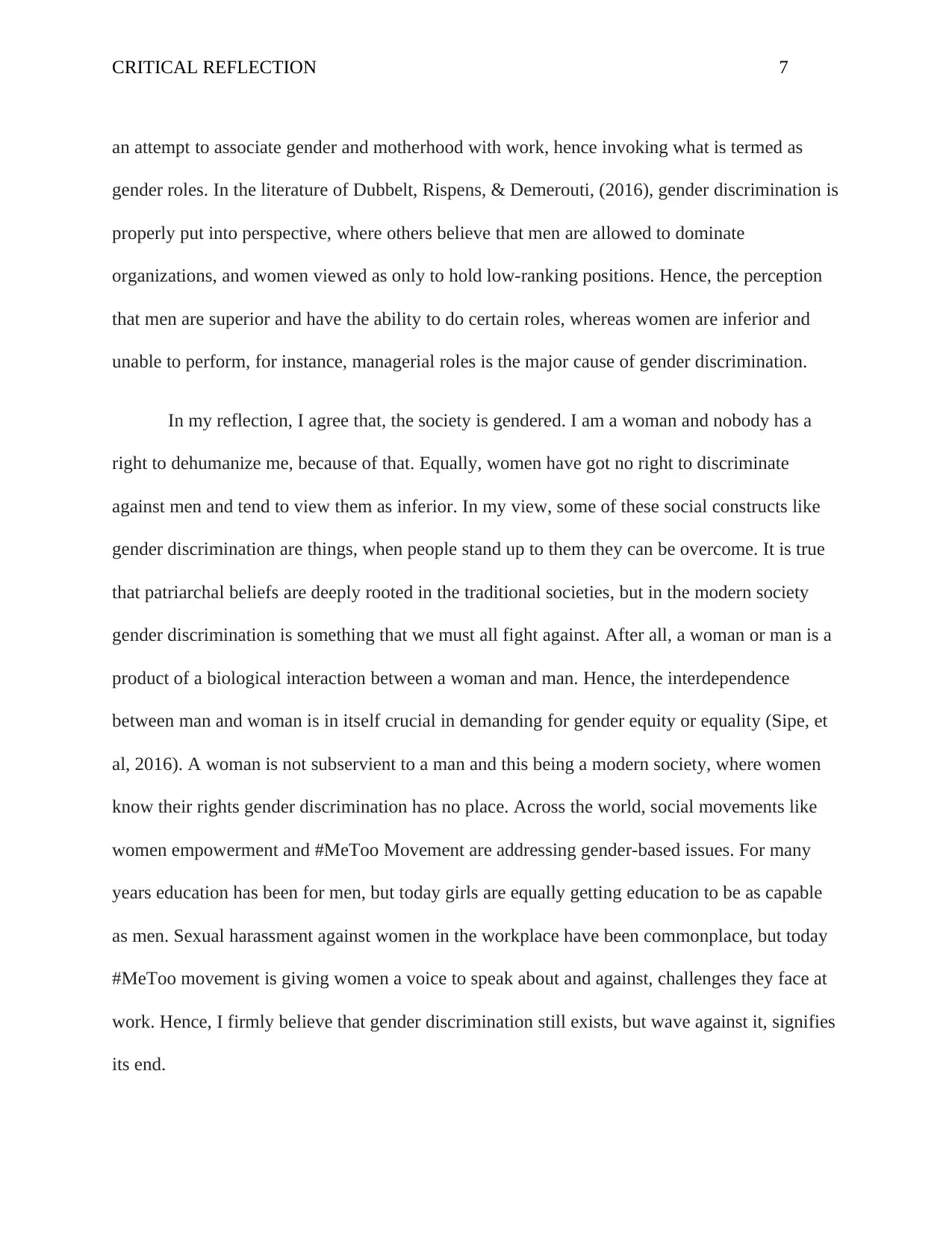
CRITICAL REFLECTION 7
an attempt to associate gender and motherhood with work, hence invoking what is termed as
gender roles. In the literature of Dubbelt, Rispens, & Demerouti, (2016), gender discrimination is
properly put into perspective, where others believe that men are allowed to dominate
organizations, and women viewed as only to hold low-ranking positions. Hence, the perception
that men are superior and have the ability to do certain roles, whereas women are inferior and
unable to perform, for instance, managerial roles is the major cause of gender discrimination.
In my reflection, I agree that, the society is gendered. I am a woman and nobody has a
right to dehumanize me, because of that. Equally, women have got no right to discriminate
against men and tend to view them as inferior. In my view, some of these social constructs like
gender discrimination are things, when people stand up to them they can be overcome. It is true
that patriarchal beliefs are deeply rooted in the traditional societies, but in the modern society
gender discrimination is something that we must all fight against. After all, a woman or man is a
product of a biological interaction between a woman and man. Hence, the interdependence
between man and woman is in itself crucial in demanding for gender equity or equality (Sipe, et
al, 2016). A woman is not subservient to a man and this being a modern society, where women
know their rights gender discrimination has no place. Across the world, social movements like
women empowerment and #MeToo Movement are addressing gender-based issues. For many
years education has been for men, but today girls are equally getting education to be as capable
as men. Sexual harassment against women in the workplace have been commonplace, but today
#MeToo movement is giving women a voice to speak about and against, challenges they face at
work. Hence, I firmly believe that gender discrimination still exists, but wave against it, signifies
its end.
an attempt to associate gender and motherhood with work, hence invoking what is termed as
gender roles. In the literature of Dubbelt, Rispens, & Demerouti, (2016), gender discrimination is
properly put into perspective, where others believe that men are allowed to dominate
organizations, and women viewed as only to hold low-ranking positions. Hence, the perception
that men are superior and have the ability to do certain roles, whereas women are inferior and
unable to perform, for instance, managerial roles is the major cause of gender discrimination.
In my reflection, I agree that, the society is gendered. I am a woman and nobody has a
right to dehumanize me, because of that. Equally, women have got no right to discriminate
against men and tend to view them as inferior. In my view, some of these social constructs like
gender discrimination are things, when people stand up to them they can be overcome. It is true
that patriarchal beliefs are deeply rooted in the traditional societies, but in the modern society
gender discrimination is something that we must all fight against. After all, a woman or man is a
product of a biological interaction between a woman and man. Hence, the interdependence
between man and woman is in itself crucial in demanding for gender equity or equality (Sipe, et
al, 2016). A woman is not subservient to a man and this being a modern society, where women
know their rights gender discrimination has no place. Across the world, social movements like
women empowerment and #MeToo Movement are addressing gender-based issues. For many
years education has been for men, but today girls are equally getting education to be as capable
as men. Sexual harassment against women in the workplace have been commonplace, but today
#MeToo movement is giving women a voice to speak about and against, challenges they face at
work. Hence, I firmly believe that gender discrimination still exists, but wave against it, signifies
its end.
Paraphrase This Document
Need a fresh take? Get an instant paraphrase of this document with our AI Paraphraser
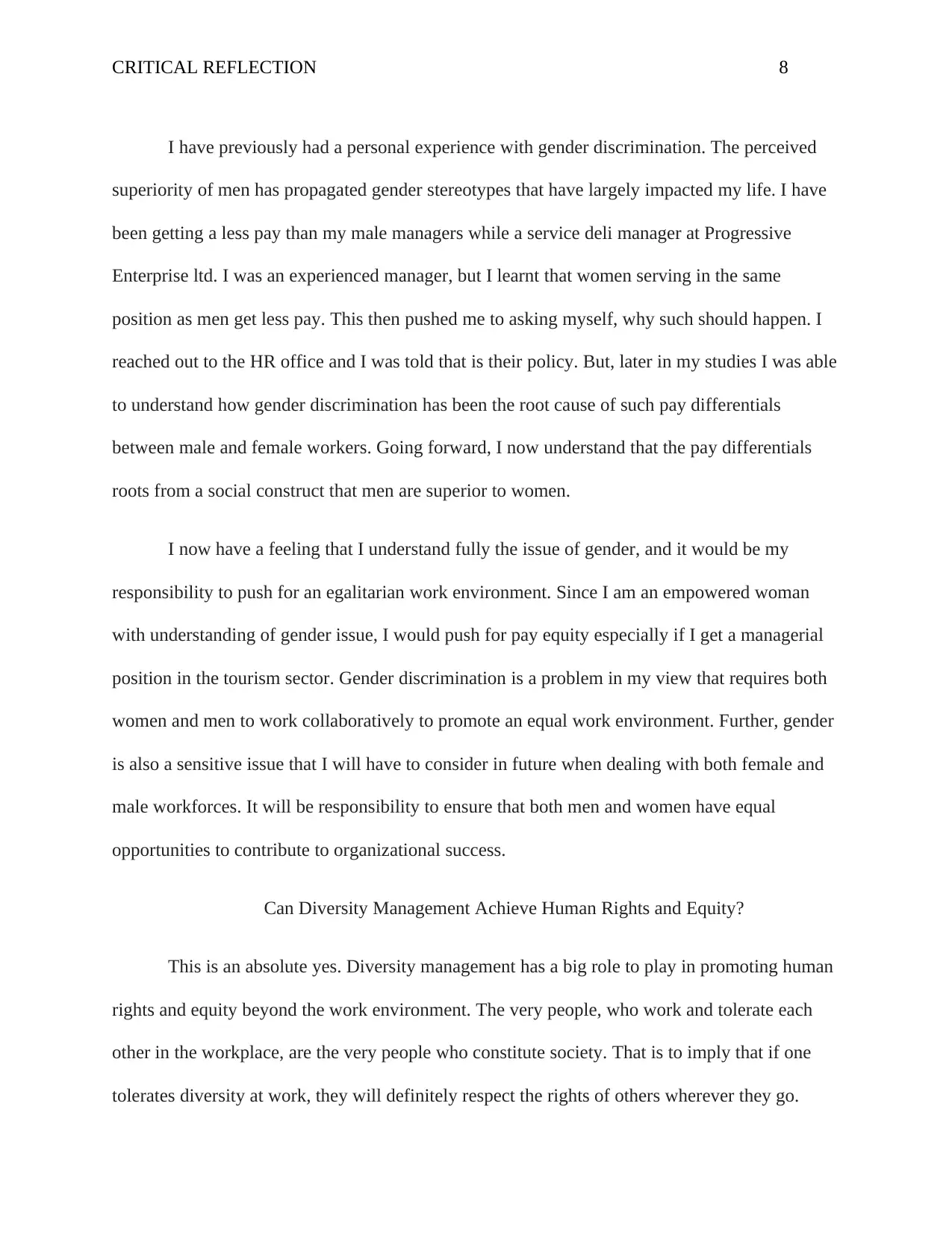
CRITICAL REFLECTION 8
I have previously had a personal experience with gender discrimination. The perceived
superiority of men has propagated gender stereotypes that have largely impacted my life. I have
been getting a less pay than my male managers while a service deli manager at Progressive
Enterprise ltd. I was an experienced manager, but I learnt that women serving in the same
position as men get less pay. This then pushed me to asking myself, why such should happen. I
reached out to the HR office and I was told that is their policy. But, later in my studies I was able
to understand how gender discrimination has been the root cause of such pay differentials
between male and female workers. Going forward, I now understand that the pay differentials
roots from a social construct that men are superior to women.
I now have a feeling that I understand fully the issue of gender, and it would be my
responsibility to push for an egalitarian work environment. Since I am an empowered woman
with understanding of gender issue, I would push for pay equity especially if I get a managerial
position in the tourism sector. Gender discrimination is a problem in my view that requires both
women and men to work collaboratively to promote an equal work environment. Further, gender
is also a sensitive issue that I will have to consider in future when dealing with both female and
male workforces. It will be responsibility to ensure that both men and women have equal
opportunities to contribute to organizational success.
Can Diversity Management Achieve Human Rights and Equity?
This is an absolute yes. Diversity management has a big role to play in promoting human
rights and equity beyond the work environment. The very people, who work and tolerate each
other in the workplace, are the very people who constitute society. That is to imply that if one
tolerates diversity at work, they will definitely respect the rights of others wherever they go.
I have previously had a personal experience with gender discrimination. The perceived
superiority of men has propagated gender stereotypes that have largely impacted my life. I have
been getting a less pay than my male managers while a service deli manager at Progressive
Enterprise ltd. I was an experienced manager, but I learnt that women serving in the same
position as men get less pay. This then pushed me to asking myself, why such should happen. I
reached out to the HR office and I was told that is their policy. But, later in my studies I was able
to understand how gender discrimination has been the root cause of such pay differentials
between male and female workers. Going forward, I now understand that the pay differentials
roots from a social construct that men are superior to women.
I now have a feeling that I understand fully the issue of gender, and it would be my
responsibility to push for an egalitarian work environment. Since I am an empowered woman
with understanding of gender issue, I would push for pay equity especially if I get a managerial
position in the tourism sector. Gender discrimination is a problem in my view that requires both
women and men to work collaboratively to promote an equal work environment. Further, gender
is also a sensitive issue that I will have to consider in future when dealing with both female and
male workforces. It will be responsibility to ensure that both men and women have equal
opportunities to contribute to organizational success.
Can Diversity Management Achieve Human Rights and Equity?
This is an absolute yes. Diversity management has a big role to play in promoting human
rights and equity beyond the work environment. The very people, who work and tolerate each
other in the workplace, are the very people who constitute society. That is to imply that if one
tolerates diversity at work, they will definitely respect the rights of others wherever they go.
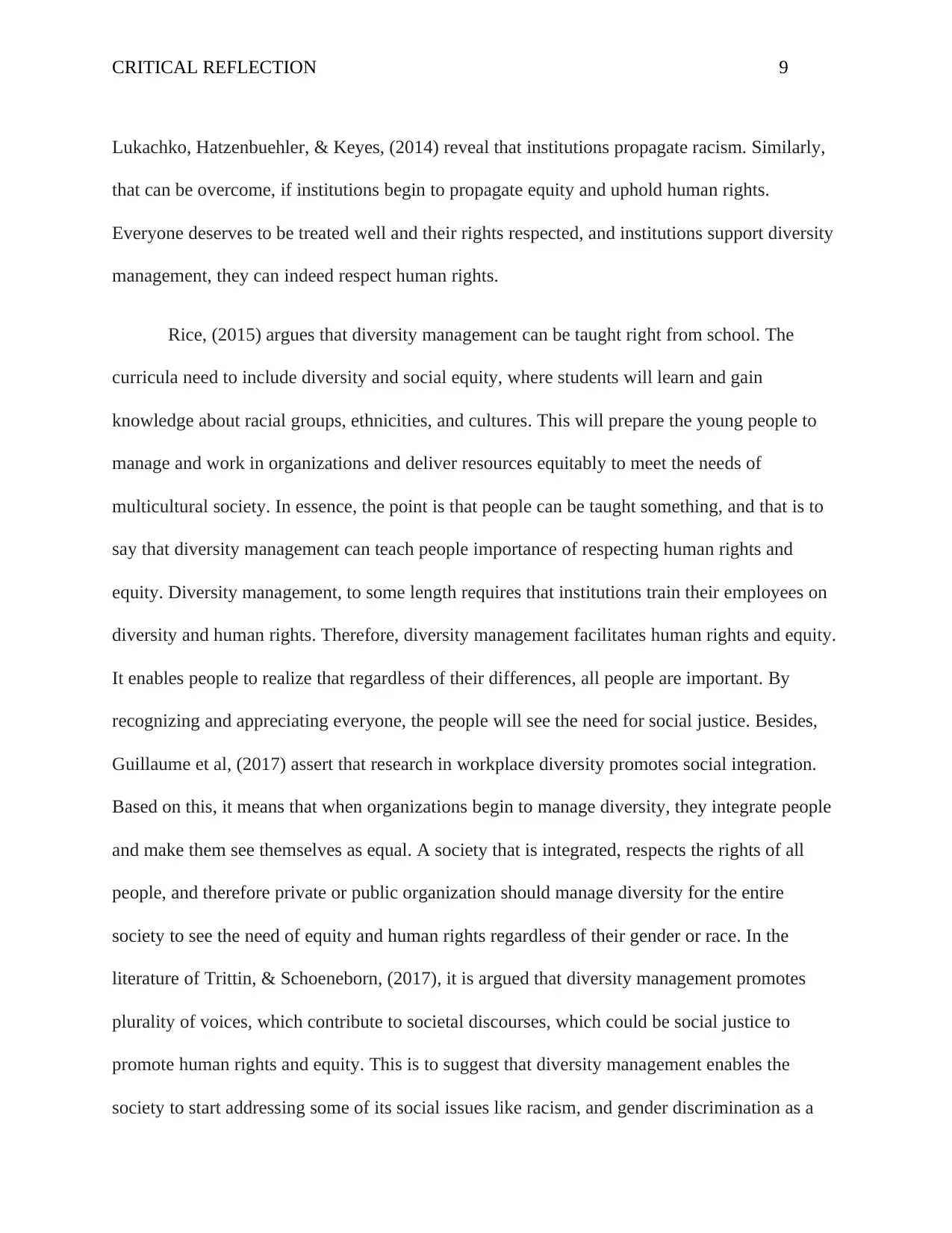
CRITICAL REFLECTION 9
Lukachko, Hatzenbuehler, & Keyes, (2014) reveal that institutions propagate racism. Similarly,
that can be overcome, if institutions begin to propagate equity and uphold human rights.
Everyone deserves to be treated well and their rights respected, and institutions support diversity
management, they can indeed respect human rights.
Rice, (2015) argues that diversity management can be taught right from school. The
curricula need to include diversity and social equity, where students will learn and gain
knowledge about racial groups, ethnicities, and cultures. This will prepare the young people to
manage and work in organizations and deliver resources equitably to meet the needs of
multicultural society. In essence, the point is that people can be taught something, and that is to
say that diversity management can teach people importance of respecting human rights and
equity. Diversity management, to some length requires that institutions train their employees on
diversity and human rights. Therefore, diversity management facilitates human rights and equity.
It enables people to realize that regardless of their differences, all people are important. By
recognizing and appreciating everyone, the people will see the need for social justice. Besides,
Guillaume et al, (2017) assert that research in workplace diversity promotes social integration.
Based on this, it means that when organizations begin to manage diversity, they integrate people
and make them see themselves as equal. A society that is integrated, respects the rights of all
people, and therefore private or public organization should manage diversity for the entire
society to see the need of equity and human rights regardless of their gender or race. In the
literature of Trittin, & Schoeneborn, (2017), it is argued that diversity management promotes
plurality of voices, which contribute to societal discourses, which could be social justice to
promote human rights and equity. This is to suggest that diversity management enables the
society to start addressing some of its social issues like racism, and gender discrimination as a
Lukachko, Hatzenbuehler, & Keyes, (2014) reveal that institutions propagate racism. Similarly,
that can be overcome, if institutions begin to propagate equity and uphold human rights.
Everyone deserves to be treated well and their rights respected, and institutions support diversity
management, they can indeed respect human rights.
Rice, (2015) argues that diversity management can be taught right from school. The
curricula need to include diversity and social equity, where students will learn and gain
knowledge about racial groups, ethnicities, and cultures. This will prepare the young people to
manage and work in organizations and deliver resources equitably to meet the needs of
multicultural society. In essence, the point is that people can be taught something, and that is to
say that diversity management can teach people importance of respecting human rights and
equity. Diversity management, to some length requires that institutions train their employees on
diversity and human rights. Therefore, diversity management facilitates human rights and equity.
It enables people to realize that regardless of their differences, all people are important. By
recognizing and appreciating everyone, the people will see the need for social justice. Besides,
Guillaume et al, (2017) assert that research in workplace diversity promotes social integration.
Based on this, it means that when organizations begin to manage diversity, they integrate people
and make them see themselves as equal. A society that is integrated, respects the rights of all
people, and therefore private or public organization should manage diversity for the entire
society to see the need of equity and human rights regardless of their gender or race. In the
literature of Trittin, & Schoeneborn, (2017), it is argued that diversity management promotes
plurality of voices, which contribute to societal discourses, which could be social justice to
promote human rights and equity. This is to suggest that diversity management enables the
society to start addressing some of its social issues like racism, and gender discrimination as a

CRITICAL REFLECTION 10
way to enhance social justice. Resultantly, human rights and equity, which broadly were
hindered due to racism and gender discrimination, shall be achieved.
Research has shown that racism, and gender are social issues that hinder diversity
tolerance, equity and respect for human rights. I believe that when society is not integrated,
people will discriminate against others based on gender or race. Importantly, when institutions
and legislators make laws that punish discriminatory behavior, people will see the need to
embrace organizational diversity. Organizations or social institutions should be at the epicenter
to manage diversity, by promoting tolerance and respect. However, since people behave
differently it is not easy to root out completely racism or gender discrimination. But, when a
majority of people are tolerant to each other, the society, organizations or institutions will have
diverse workforce to support progressive agenda to benefit all people.
way to enhance social justice. Resultantly, human rights and equity, which broadly were
hindered due to racism and gender discrimination, shall be achieved.
Research has shown that racism, and gender are social issues that hinder diversity
tolerance, equity and respect for human rights. I believe that when society is not integrated,
people will discriminate against others based on gender or race. Importantly, when institutions
and legislators make laws that punish discriminatory behavior, people will see the need to
embrace organizational diversity. Organizations or social institutions should be at the epicenter
to manage diversity, by promoting tolerance and respect. However, since people behave
differently it is not easy to root out completely racism or gender discrimination. But, when a
majority of people are tolerant to each other, the society, organizations or institutions will have
diverse workforce to support progressive agenda to benefit all people.
Secure Best Marks with AI Grader
Need help grading? Try our AI Grader for instant feedback on your assignments.
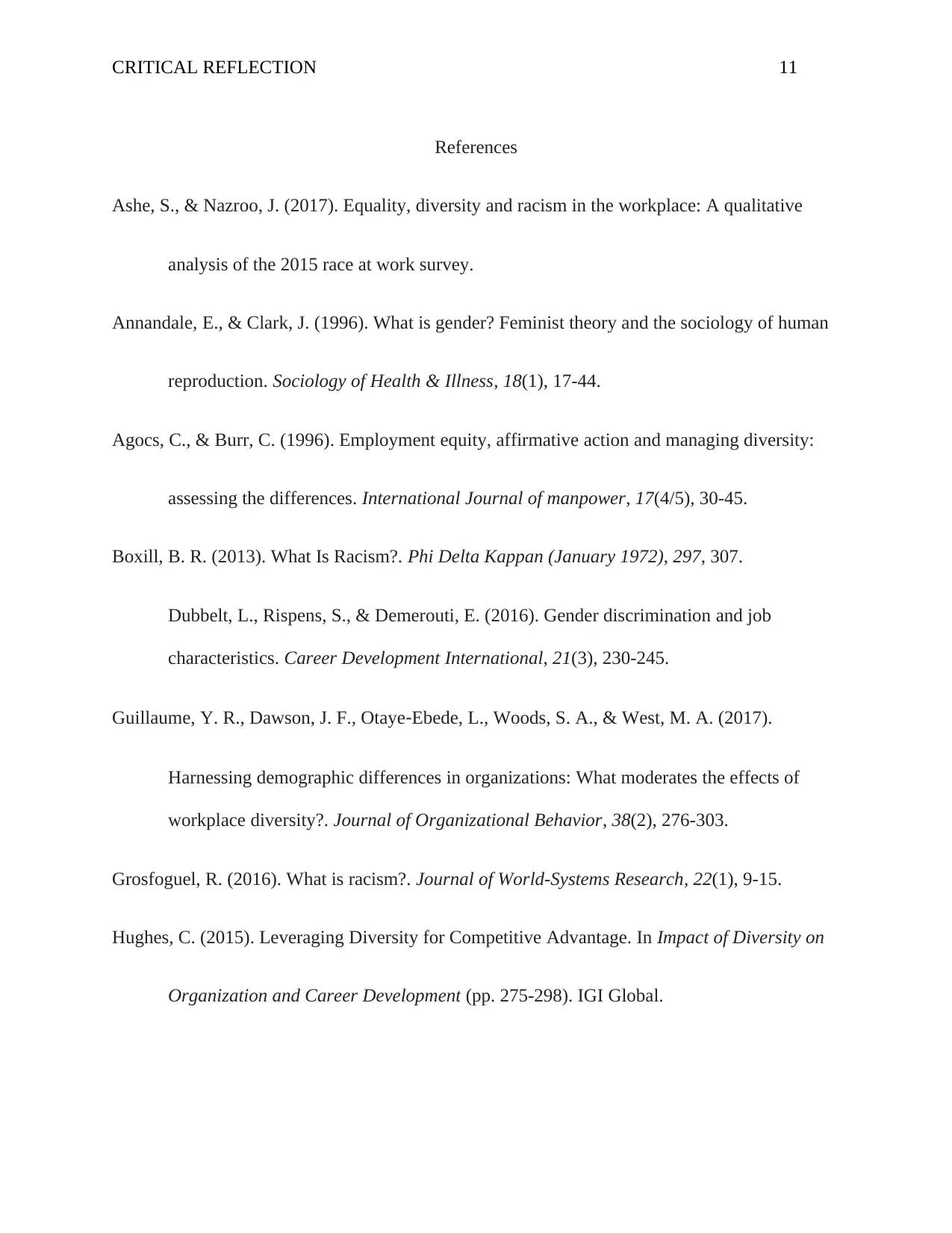
CRITICAL REFLECTION 11
References
Ashe, S., & Nazroo, J. (2017). Equality, diversity and racism in the workplace: A qualitative
analysis of the 2015 race at work survey.
Annandale, E., & Clark, J. (1996). What is gender? Feminist theory and the sociology of human
reproduction. Sociology of Health & Illness, 18(1), 17-44.
Agocs, C., & Burr, C. (1996). Employment equity, affirmative action and managing diversity:
assessing the differences. International Journal of manpower, 17(4/5), 30-45.
Boxill, B. R. (2013). What Is Racism?. Phi Delta Kappan (January 1972), 297, 307.
Dubbelt, L., Rispens, S., & Demerouti, E. (2016). Gender discrimination and job
characteristics. Career Development International, 21(3), 230-245.
Guillaume, Y. R., Dawson, J. F., Otaye‐Ebede, L., Woods, S. A., & West, M. A. (2017).
Harnessing demographic differences in organizations: What moderates the effects of
workplace diversity?. Journal of Organizational Behavior, 38(2), 276-303.
Grosfoguel, R. (2016). What is racism?. Journal of World-Systems Research, 22(1), 9-15.
Hughes, C. (2015). Leveraging Diversity for Competitive Advantage. In Impact of Diversity on
Organization and Career Development (pp. 275-298). IGI Global.
References
Ashe, S., & Nazroo, J. (2017). Equality, diversity and racism in the workplace: A qualitative
analysis of the 2015 race at work survey.
Annandale, E., & Clark, J. (1996). What is gender? Feminist theory and the sociology of human
reproduction. Sociology of Health & Illness, 18(1), 17-44.
Agocs, C., & Burr, C. (1996). Employment equity, affirmative action and managing diversity:
assessing the differences. International Journal of manpower, 17(4/5), 30-45.
Boxill, B. R. (2013). What Is Racism?. Phi Delta Kappan (January 1972), 297, 307.
Dubbelt, L., Rispens, S., & Demerouti, E. (2016). Gender discrimination and job
characteristics. Career Development International, 21(3), 230-245.
Guillaume, Y. R., Dawson, J. F., Otaye‐Ebede, L., Woods, S. A., & West, M. A. (2017).
Harnessing demographic differences in organizations: What moderates the effects of
workplace diversity?. Journal of Organizational Behavior, 38(2), 276-303.
Grosfoguel, R. (2016). What is racism?. Journal of World-Systems Research, 22(1), 9-15.
Hughes, C. (2015). Leveraging Diversity for Competitive Advantage. In Impact of Diversity on
Organization and Career Development (pp. 275-298). IGI Global.
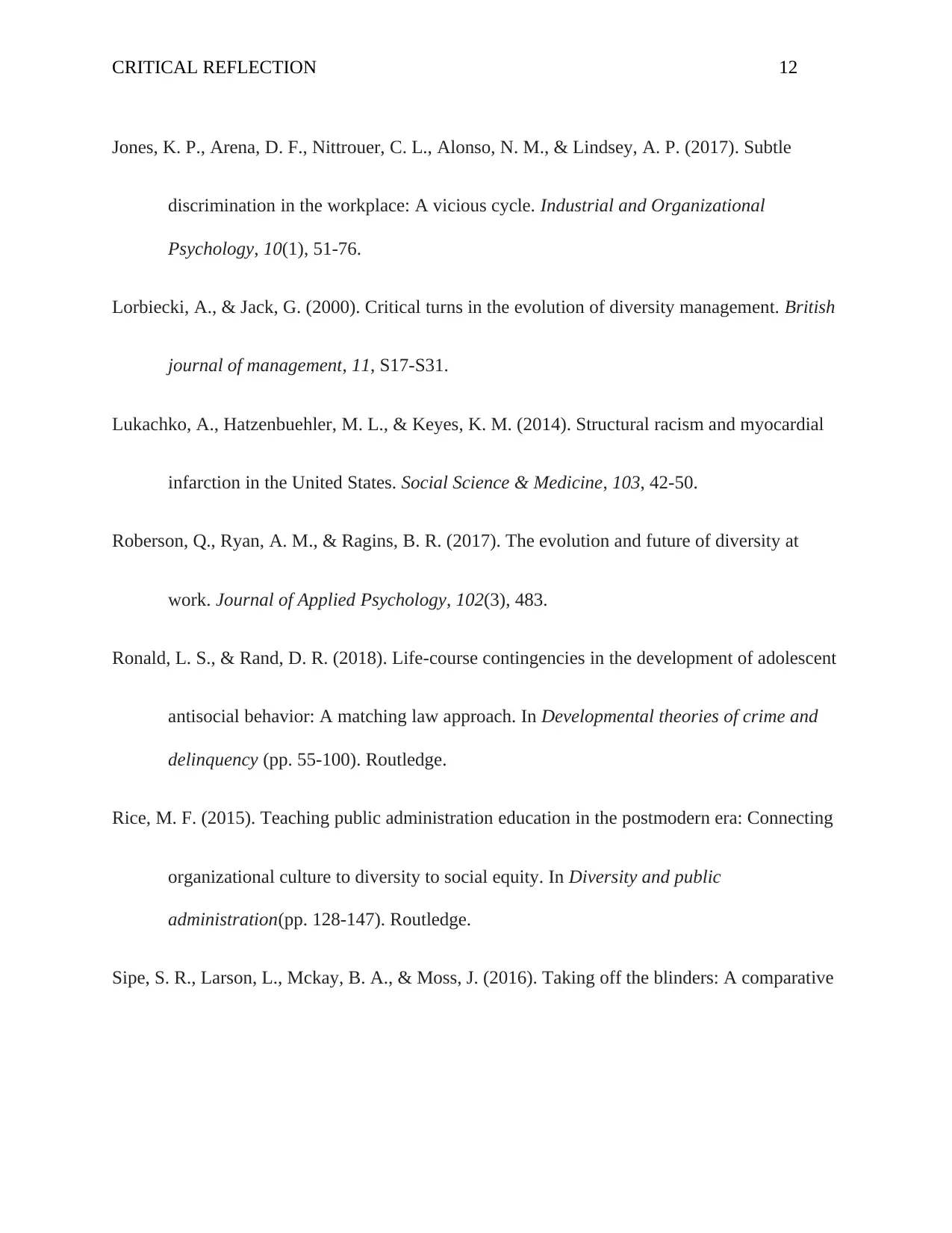
CRITICAL REFLECTION 12
Jones, K. P., Arena, D. F., Nittrouer, C. L., Alonso, N. M., & Lindsey, A. P. (2017). Subtle
discrimination in the workplace: A vicious cycle. Industrial and Organizational
Psychology, 10(1), 51-76.
Lorbiecki, A., & Jack, G. (2000). Critical turns in the evolution of diversity management. British
journal of management, 11, S17-S31.
Lukachko, A., Hatzenbuehler, M. L., & Keyes, K. M. (2014). Structural racism and myocardial
infarction in the United States. Social Science & Medicine, 103, 42-50.
Roberson, Q., Ryan, A. M., & Ragins, B. R. (2017). The evolution and future of diversity at
work. Journal of Applied Psychology, 102(3), 483.
Ronald, L. S., & Rand, D. R. (2018). Life-course contingencies in the development of adolescent
antisocial behavior: A matching law approach. In Developmental theories of crime and
delinquency (pp. 55-100). Routledge.
Rice, M. F. (2015). Teaching public administration education in the postmodern era: Connecting
organizational culture to diversity to social equity. In Diversity and public
administration(pp. 128-147). Routledge.
Sipe, S. R., Larson, L., Mckay, B. A., & Moss, J. (2016). Taking off the blinders: A comparative
Jones, K. P., Arena, D. F., Nittrouer, C. L., Alonso, N. M., & Lindsey, A. P. (2017). Subtle
discrimination in the workplace: A vicious cycle. Industrial and Organizational
Psychology, 10(1), 51-76.
Lorbiecki, A., & Jack, G. (2000). Critical turns in the evolution of diversity management. British
journal of management, 11, S17-S31.
Lukachko, A., Hatzenbuehler, M. L., & Keyes, K. M. (2014). Structural racism and myocardial
infarction in the United States. Social Science & Medicine, 103, 42-50.
Roberson, Q., Ryan, A. M., & Ragins, B. R. (2017). The evolution and future of diversity at
work. Journal of Applied Psychology, 102(3), 483.
Ronald, L. S., & Rand, D. R. (2018). Life-course contingencies in the development of adolescent
antisocial behavior: A matching law approach. In Developmental theories of crime and
delinquency (pp. 55-100). Routledge.
Rice, M. F. (2015). Teaching public administration education in the postmodern era: Connecting
organizational culture to diversity to social equity. In Diversity and public
administration(pp. 128-147). Routledge.
Sipe, S. R., Larson, L., Mckay, B. A., & Moss, J. (2016). Taking off the blinders: A comparative
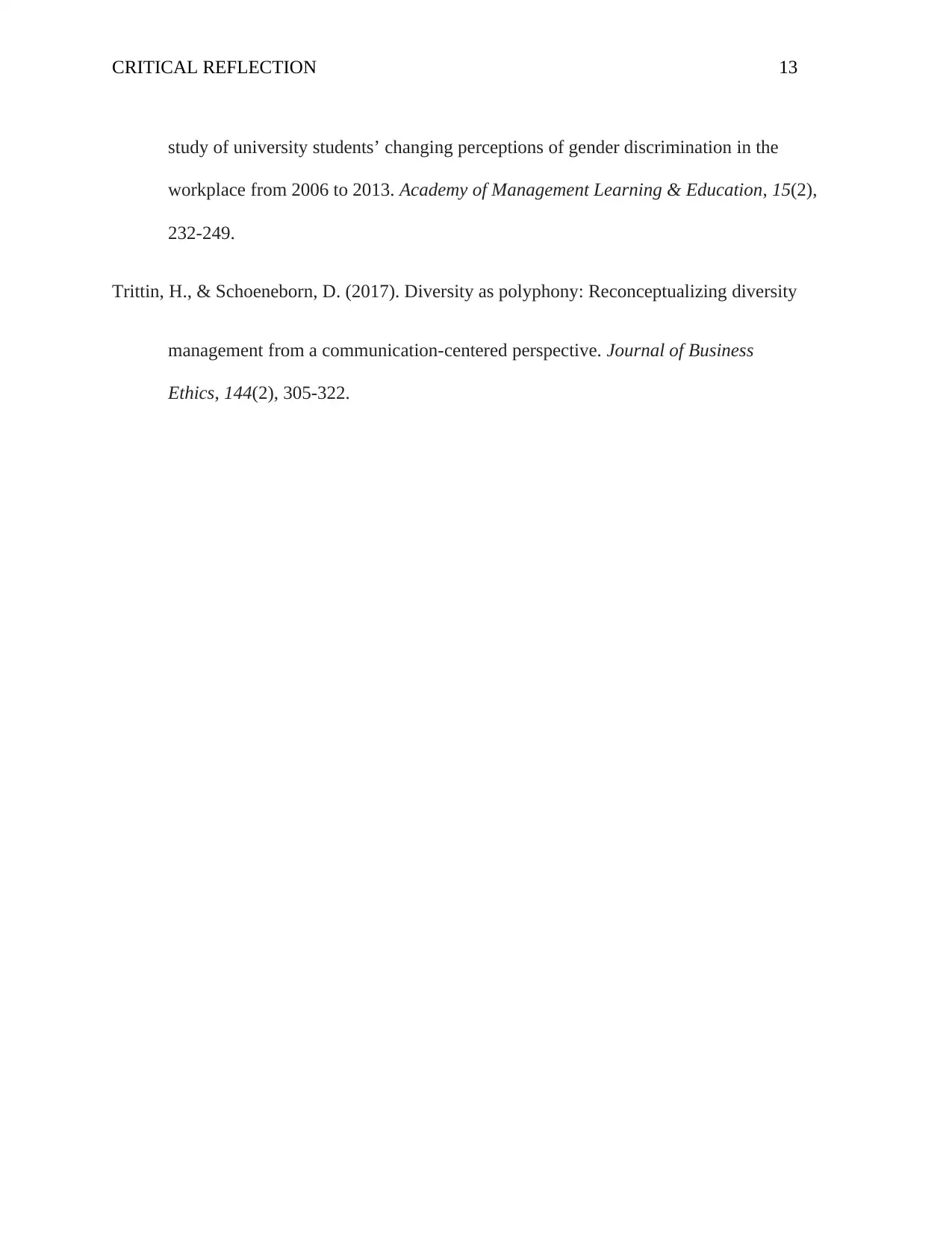
CRITICAL REFLECTION 13
study of university students’ changing perceptions of gender discrimination in the
workplace from 2006 to 2013. Academy of Management Learning & Education, 15(2),
232-249.
Trittin, H., & Schoeneborn, D. (2017). Diversity as polyphony: Reconceptualizing diversity
management from a communication-centered perspective. Journal of Business
Ethics, 144(2), 305-322.
study of university students’ changing perceptions of gender discrimination in the
workplace from 2006 to 2013. Academy of Management Learning & Education, 15(2),
232-249.
Trittin, H., & Schoeneborn, D. (2017). Diversity as polyphony: Reconceptualizing diversity
management from a communication-centered perspective. Journal of Business
Ethics, 144(2), 305-322.
Paraphrase This Document
Need a fresh take? Get an instant paraphrase of this document with our AI Paraphraser

CRITICAL REFLECTION 14
1 out of 14
Related Documents
Your All-in-One AI-Powered Toolkit for Academic Success.
+13062052269
info@desklib.com
Available 24*7 on WhatsApp / Email
![[object Object]](/_next/static/media/star-bottom.7253800d.svg)
Unlock your academic potential
© 2024 | Zucol Services PVT LTD | All rights reserved.





